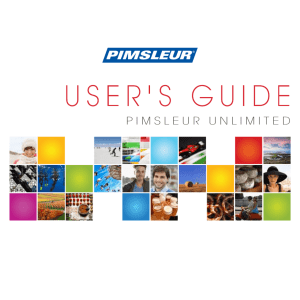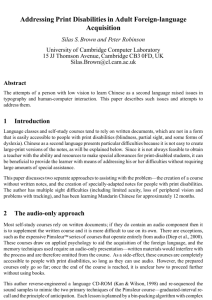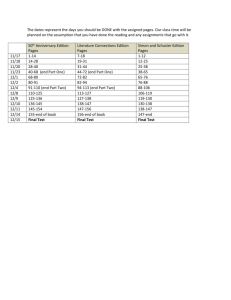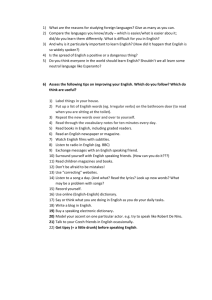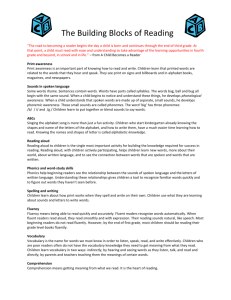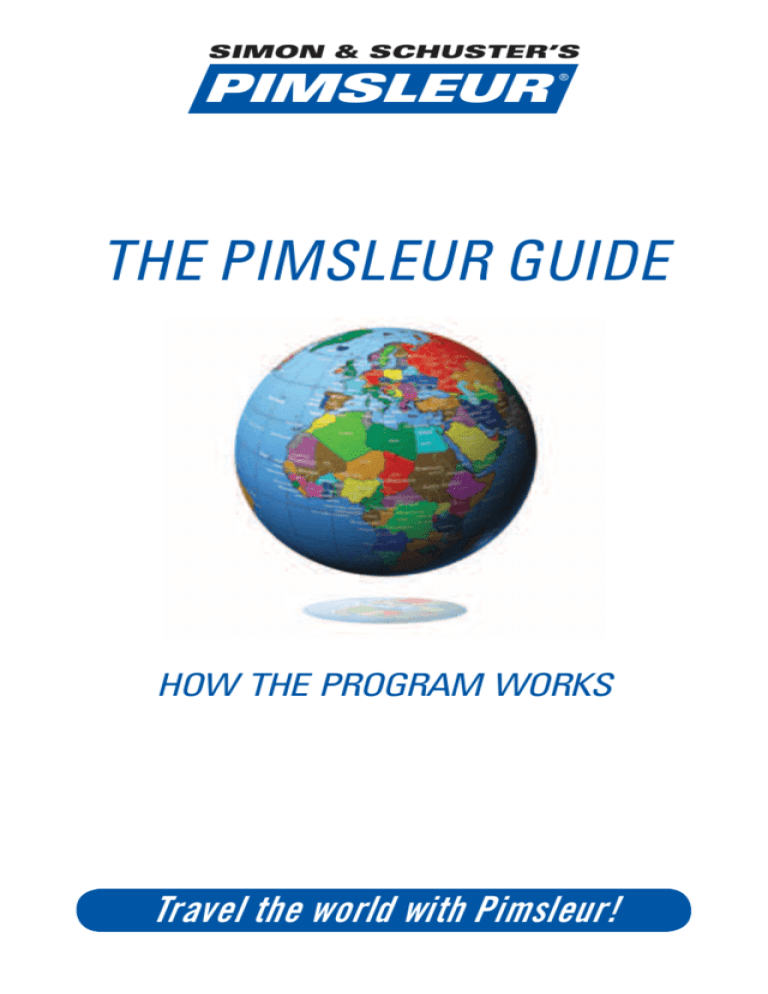
SIMON & SCHUSTER’S
PIMSLEUR
®
THE PIMSLEUR GUIDE
how the program works
Travel the world with Pimsleur!
PIMSLEUR® LANGUAGE PROGRAMS
You have just purchased the most effective language program
ever developed. As you probably know, learning a new language
can be frustrating. Your first experience with a foreign language
may have been in school. If the classes seemed difficult, or if your
grades were poor, you probably believed you had no aptitude for
languages. Even if you did well, you may have been surprised
later to discover that what you learned was of little or no use
when you tried to converse with native speakers.
Perhaps you waited until later in life and tried adult education
classes, language schools, or home training programs. There too
you may have found the information hard to retain, the lessons
tedious, and your progress slow. Many language students give up
early in these programs, convinced they lack the natural ability
to understand and use what they read and hear.
The truth is that anyone can acquire a foreign language—
with the right teaching system. With the Pimsleur® Method,
you will benefit from the years of research and development
that have helped create the world’s most effective method for
teaching foreign languages. The Pimsleur® Language Programs,
developed by Dr. Paul Pimsleur, fill an urgent need for selfinstructional materials in many languages.
HOW TO USE THE PROGRAM
To get the full benefit of each lesson, choose a quiet place
where you can practice without interruption and a time of day
when your mind is most alert and your body least fatigued.
The length of each lesson, just under 30 minutes, is that
recommended by teaching specialists for a concentrated learning
task. Once you’ve started the program, simply follow the tutor’s
instructions. The most important instruction is to respond aloud
when the tutor tells you to do so. There will be a pause after
this instruction, giving you time to reply. It is essential to your
progress that you speak out in a normal conversational voice
when asked to respond. Your active participation in thinking and
speaking is required for your success in mastering this course.
The simple test for mastery is whether you are able to respond
quickly and accurately when your tutor asks a question. If you
are responding correctly about eighty percent of the time, then
you’re ready to proceed to the next lesson. It is important to keep
moving forward, and also not to set unreasonable standards of
perfection that will keep you from progressing, which is why we
recommend using the eighty percent figure as a guide.
You will notice that each lesson contains both new and
familiar material, and just when you may be worrying about
forgetting something, you will conveniently be reminded of it.
Another helpful feature of the Pimsleur® Language Program is
its rate of “saturation.” You will be responding many times in
the half-hour. This saturation enables you to make substantial
progress within a short period of time.
2
GUIDELINES FOR SUCCESS
Complete the lesson units in strict consecutive order (don’t
skip around), doing no more than one lesson per day, although
the lesson unit for the day may be repeated more than once. Daily
contact with the language is critical to successful learning.
Listen carefully to each lesson unit. Always follow the
directions of the instructor.
Speak out loud when directed by the tutor and answer
questions within the pauses provided. It is not enough to just
silently “think” of the answer to the question asked. You need to
speak the answer out loud to set up a “circuit” of the language
you are learning to speak so that it is heard and identified through
your ears, to help to establish the “sounds” of the target language.
Do this prior to hearing the confirmation, which is provided as
reinforcement, as well as additional speech training.
Do all required activities according to the instructions,
without reference to any outside persons, book, or course.
Do not have a paper and pen nearby during the lessons,
and do not refer to dictionaries or other books. The Pimsleur®
Method works with the language-learning portion of your brain,
requiring language to be processed in its spoken form. Not only
will you interrupt the learning process if you attempt to write the
words that you hear, but you will also begin to speak the target
language with an American accent. This is because the “sounds”
represented by the American letters are different from the samelooking letters from the foreign language.
3
DR. PAUL PIMSLEUR AND HIS UNIQUE METHOD
Dr. Paul Pimsleur devoted his life to language teaching and
testing and was one of the world’s leading experts in applied
linguistics. He was fluent in French, good in German, and had
a working knowledge of Italian, Russian, Modern Greek, and
Mandarin Chinese. After obtaining his Ph.D. in French and a
Masters in Psychology from Columbia University, he taught
French Phonetics and Linguistics at UCLA. He later became
Professor of Romance Languages and Language Education, and
Director of The Listening Center (a state-wide language lab)
at Ohio State University; Professor of Education and Romance
Languages at the State University of New York at Albany; and
a Fulbright lecturer at the University of Heidelberg. He did
research on the psychology of language learning and in 1969
was Section Head of Psychology of Second Language Learning
at the International Congress of Applied Linguistics.
Dr. Pimsleur was a member of the American Association of
Teachers of French (AATF), American Educational Research
Association (AERA), Modern Language Association (MLA),
and a founding member of the American Council on the Teaching
of Foreign Languages (ACTFL).
His many books and articles revolutionized theories of
language learning and teaching. After years of experience and
research, Dr. Pimsleur developed a new method (The Pimsleur
Method) that is based on two key principles: the “Principle of
Anticipation” and a scientific principle of memory training
that he called “Graduated Interval Recall.” This Method has
been applied to the many levels and languages of the Pimsleur
Programs.
4
GRADUATED INTERVAL RECALL
The term, “Graduated Interval Recall” is a complex name
for a very simple theory about memory. No aspect of learning a
foreign language is more important than memory, yet before Dr.
Pimsleur, no one had explored more effective ways for building
language memory.
In his research, Dr. Pimsleur discovered how long students
remembered new information and at what intervals they needed
to be reminded of it. If reminded too soon or too late, they failed
to retain the information. This discovery enabled him to create
a schedule of exactly when and how the information should be
reintroduced.
Suppose you have learned a new word. You tell yourself to
remember it. However, after five minutes you’re unable to recall
it. If you’d been reminded of it after five seconds, you probably
would have remembered it for maybe a minute, at which time
you would have needed another reminder. Each time you are
reminded, you remember the word longer than you did the time
before. The intervals between reminders become longer and
longer, until you eventually remember the word without being
reminded at all.
This program is carefully designed to remind you of new
information at the exact intervals where maximum retention
takes place. Each time your memory begins to fade, you will be
asked to recall the word.
5
PRINCIPLE OF ANTICIPATION
The “Principle of Anticipation” requires you to anticipate
a correct answer. Practically, what this means is that you must
retrieve the answer from what you have learned earlier in the
course. It works by posing a question, asking you to provide a new
sentence, using information you’ve learned previously and putting
it into a new combination. This provides novelty and excitement
which accelerates learning.
A possible scenario:
Speaker’s cue: “Are you going to the movies today?”
(PAUSE)
Drawing on information given previously, you respond
(in the target language):
“No, I’m going tomorrow.”
The instructor will then confirm your answer:
“No, I’m going tomorrow.”
The Narrator then may cue:
“Is your sister going to Europe this year?” (PAUSE)
Response: “No, she went last year.”
Before Dr. Pimsleur created his teaching method, language
courses were based on the principle of “mindless-repetition.”
Teachers drummed words into the students’ minds over and over,
as if there were grooves in the mind that could be worn deeper
with repetition.
Neurophysiologists tell us however, that on the contrary, simple
and unchallenging repetition has a hypnotic, even dulling effect
on the learning process. Eventually, the words being repeated
will lose their meaning. Dr. Pimsleur discovered that learning
accelerates when there is an “input/output” system of interaction,
in which students receive information and then are asked to
retrieve and use it.
6
CORE VOCABULARY
While “Graduated Interval Recall” and the “Principle of
Anticipation” are the foundation of the Pimsleur® Method, there
are other aspects that contribute to its uniqueness and effectiveness.
One involves vocabulary. We have all been intimidated, when
approaching a new language, by the sheer immensity of the
number of new words we must learn. But extensive research has
shown that we actually need a comparatively limited number of
words to be able to communicate effectively in any language.
Language can be divided into two distinct categories:
grammatical structures (function words) and concrete vocabulary
(content words). By focusing on the former category and enabling
the student to comprehend and employ the structure of the new
language, Dr. Pimsleur found that language learners were able to
more readily put new knowledge to use. There are few content
words that must be known and used every day. The essential
“core” of a language involves function words, which tend to
relate to human activities.
This course is designed to teach you to understand and to
speak the essential elements of your new language in a relatively
short time. During each half-hour lesson, you will actually
converse with two native speakers, using the level of language
spoken by educated citizens in their everyday business and social
life. The program’s unique method of presenting dialogue insituation relieves you of the most common learning problem, the
problem of meaning.
7
ORGANIC LEARNING
The
Pimsleur® Method centers on teaching functional
mastery in understanding and speaking a language, in the most
effective and efficient way possible. You will be working on
your vocabulary, grammar, and pronunciation in an integrated
manner, as you are learning specific phrases that have practical
use in everyday activities.
There are several thousand languages in the world. Because
fewer than five hundred of these languages have developed formal
systems of writing, linguistic specialists accept that language
is primarily speech. For this reason, it is also accepted that the
human brain acquires language as speech. Therefore, when Dr.
Pimsleur created his language programs, he began teaching with
recorded materials, which enabled the learners to acquire the
sounds, the rhythm, and the intonation of the target language.
The learners did this more rapidly, more accurately, and with
great enthusiasm because they found themselves capable of
almost instant beginning communication skills.
Dr. Pimsleur called this “organic learning” because it involves
learning on several fronts at the same time. His system enables
the learner to acquire grammatical usage, vocabulary, and the
“sounds” of the language in an integrated, exciting way. In short,
the learner gains the language as a living, expressive form of
human culture.
8
COURSE CONTENT
When you have mastered a Pimsleur® Language Program,
you will have a highly-practical, every-day vocabulary at your
command. These basic words, phrases, and sentences have been
carefully selected to be the most useful in everyday situations
when you visit a foreign country. You will be able to handle
social encounters graciously, converse with native speakers in
travel situations, and use transportation systems with confidence.
You’ll be able to ask directions and to navigate your own way
around the cities and countryside.
The language skills you learn will enable you to participate
in casual conversations, express facts, give instructions, and
describe current, past, and future activities. You will be able to
deal with everyday survival topics and courtesy requirements.
You will be intelligible to native speakers of the language—even
to those who are not used to dealing with foreigners. What is
equally important, you will know how to ask the kinds of
questions that will further expand your knowledge of and facility
with the language, because you will have been trained by the
Pimsleur® open-ended questioning technique.
The Pimsleur® Method becomes a springboard for further
learning and growth to take place—the ultimate purpose of any
real educational system. This desire to learn will be apparent to
the people with whom you speak. It will indicate sincere interest
in and respect for their culture.
9
A NOTE ON REGIONAL LANGUAGE DIFFERENCES
In any large country, and even in many smaller countries,
regional differences in language are common. In the United States,
for example, a person from Maine can sound very different than
someone from Texas. Pronunciations (“accents”) vary, and there
are also minor differences in vocabulary. For example, what is
called a “drinking fountain” in New York or Arizona is known
as a “bubbler” in Wisconsin, and a “soft drink” in one part of
America will be called a “soda” elsewhere. The differences in
English are even more distinct between North Americans and
Britons, or between Britons and Australians. But all are native
speakers of English; all can communicate with spoken English,
read the same newspapers, and watch the same television
programs, essentially without difficulty.
Native speakers of a language can often tell where someone
is from by listening to him or her speak. In addition to regional
differences, there are social differences. Pimsleur® Language
Programs use a standard “educated” speech, which will generally
carry you throughout the country without difficulty.
10
Reading in a Pimsleur Program
A phonetic alphabet, such as the Latin alphabet and the Greek
alphabet, is a list of symbols (letters) that are used to represent the
sounds of the language in writing. And given that language is
primarily speech, the spoken sounds of the language necessarily
precede learning how to decode the written form, i.e., learning
how to “read” – just as a child first learns to speak and then
eventually to read. This is the natural progression Dr. Pimsleur
followed in his courses.
After an initial introduction to the spoken language, reading
is then integrated into the program and the new alphabet is
systematically introduced, associating each letter with the
sounds of the new language. Initially, you are sounding out
words, mastering the different sounds associated with the new
alphabet. You are not, at first, reading for meaning, but rather for
sound/symbol correlation. Eventually, when the sound system
is mastered, you will be able to look at known vocabulary and
“read for meaning.” By the end of the first 30 lessons, you will
be reading at the same level as you are speaking.
11
Pimsleur covers the world of languages. You can choose from
over 60 language programs, many with multiple levels, ranging
from the most popular to the exotic. Become a Pimsleur
learner and travel the world!
Programs available for these languages:
• Japanese
• Albanian
• Korean
• Arabic (Eastern)
• Lithuanian
• Arabic (Egyptian)
• Norwegian
• Arabic (Modern Standard) • Ojibwe
• Armenian (Eastern)
• Pashto • Armenian (Western)
• Polish
• Chinese (Cantonese)
• Portuguese (Brazilian)
• Chinese (Mandarin)
• Portuguese (European)
• Croatian
• Punjabi
• Czech
• Romanian
• Danish
• Russian
• Dari (Persian)
• Spanish
• Dutch
• Swahili
• Farsi (Persian)
• Swedish
• French
• Swiss German
• German
• Tagalog
• Greek (Modern)
• Thai
• Haitian Creole
• Turkish
• Hebrew (Modern)
• Twi
• Hindi
• Ukrainian
• Hungarian
• Urdu
• Indonesian
• Vietnamese
• Irish
• Italian
ESL (English as a Second Language):
• Arabic
• Chinese (Cantonese)
• Chinese (Mandarin)
• French
• German
• Haitian
• Hindi
• Italian
• Korean
• Persian
• Portuguese
• Russian
• Spanish
• Vietnamese
SIMON & SCHUSTER’S
PIMSLEUR
®
Pimsleur® Language Programs are available
in all of the commonly spoken languages. Many other languages are also available.
For more information, call 1-800-831-5497
or visit us at www.Pimsleur.com
© 1997 Simon & Schuster, Inc.
Pimsleur® is an imprint of Simon & Schuster Audio,
a division of Simon & Schuster, Inc. Mfg. in USA. All rights reserved.
Pimsleur® is a registered trademark of Beverly Pimsleur,
used by Simon & Schuster under exclusive license.


